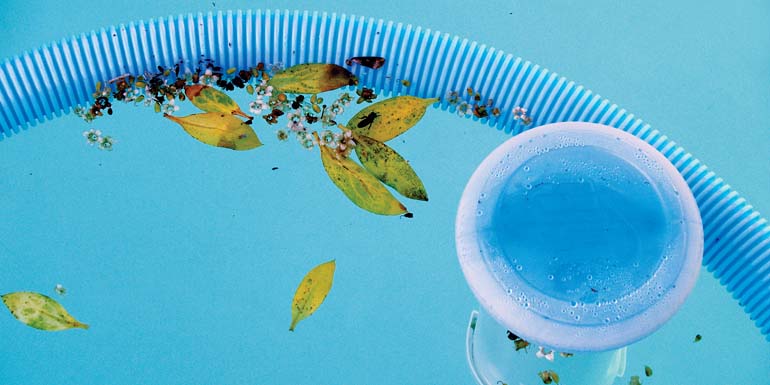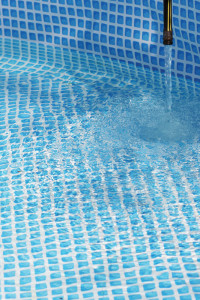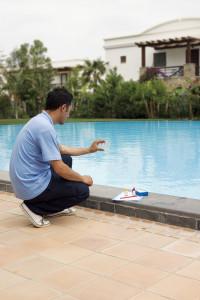Understanding phosphates
by Sally Bouorm | December 1, 2011 3:44 pm
 [1]
[1]By Joe Sweazy
No unwelcome guest can ruin a swimming pool experience like algae. Often stubborn and recurrent, that uninvited guest (algae) needs two things in order to grow and reproduce in a swimming pool—water and nutrients. As this article discusses swimming pools, water is a given. However, one of the key nutrients scientists are studying is how to more effectively control phosphate.
Phosphate is a naturally occurring mineral in nature. Phosphates and other nutrients are required by all living organisms, including algae, to develop and reproduce. Due to the abundance of phosphorus-containing sources, a swimming pool can become an algae factory in no time. Phosphate levels build up quickly, especially in pools that are poorly maintained with insufficient sanitizer levels and unfavourable water balance parameters. However, properly maintained pools do not usually experience difficulties in controlling algae, even with the presence of moderate to high phosphate levels. Yet, even these pools will have periods when the water becomes unbalanced and unfortunately, this is when high phosphate levels can become problematic.
How do phosphates enter the water?
Understanding how phosphates get into the pool water is the first step in taking control. In fact, the list of things that do not contribute phosphates to the pool is probably shorter, but what fun would that be?
 [2]
[2]One of the most common sources of phosphate contamination is fertilizer. In order for grass to grow lush and green, fertilizers, which contain high phosphorus levels, are applied. If a lawn service company maintains the pool owner’s property, or even a neighbouring property, it is possible for the fertilizer to drift into the swimming pool on windy days, or simply via careless overspray. It can also enter the pool via leaching water around the pool area, from kids tracking it in on their feet, or from items laying in the yard brought into the pool.
Believe it or not, phosphates can be introduced to pool water from a variety of other sources as well, including the source water used to fill or top off the pool. For instance, municipal water systems add a low level of phosphates to help clean the lines leading from the treatment plant to the pool water source. Well water is also likely to contain some level of phosphates, which may even be higher than city water levels.
Dead and decaying organic matter in the swimming pool, e.g. leaves, seeds, pollen, grass clippings, flowers and bugs also introduce phosphate to the water as they decay in the skimmer basket or on the pool floor.
Bathers are another common cause, as a variety of contaminants can be introduced via the human body. For example, phosphates can come from detergent on swimsuits and clothing, as well as from dead skin cells, sweat, oils and lotions. To make matters worse, should the family pet be allowed to swim in the pool, even more phosphates can be introduced to the water than from bathers themselves.
Finally, what good is a list of phosphate sources without addressing the weather? The weather is blamed for everything in the swimming pool industry, and when it comes to phosphate problems, it is no different. Rain, sleet, dust and dirt from every rain shower and storm is likely to contribute phosphates. The level certainly varies by region and increases with pollution usually associated with large cities.
This list can go on; however, the important thing to keep in mind is that phosphates—not matter what—are going to get into the swimming pool.
How are phosphates controlled?
The first and easiest step in controlling phosphate levels is to limit the amount of phosphates that are introduced to the pool. This can be accomplished by covering the pool when nearby lawns or golf courses are being treated and during high winds when organic debris can be easily blown into the water. It is also a good idea to keep the pool covered as often as possible during high pollen count seasons and when trees and plants have seeds, leaves and blossoms blowing around. Should any organic matter enter the pool, ensure it is removed before it has a chance to decay and release unwanted phosphates. Also, encourage pool owners to shower before entering their pool area and suggest the idea of keeping a poolside wash station where they can rinse their dirty feet before re-entering the pool.
 [3]
[3]The next step is water treatment. As mentioned earlier, maintaining proper chlorine (Cl) levels, along with a balanced pH and alkalinity (AT), will usually prevent algae outbreaks from occurring. However, there are bound to be seasons when this does not go according to plan. When this happens, phosphate removal chemicals can be used to help prevent an algae outbreak—even if is challenging to control the other water parameters for a short time.
Phosphate removal chemicals are typically based on a lanthanum (a rare earth element) compound, although some newer technology is emerging. When added to the pool, these compounds react with phosphates in the water and precipitate them from solution. At this point, they can be effectively removed from the water via filtration or vacuuming.
Phosphate removal treatments in the spring and fall are also a good idea if phosphate levels were problematic throughout the year. A spring start-up dose is recommended if leaves and other debris have been sitting in the pool, decaying throughout the winter or if algae is present.
This treatment may cause temporary water cloudiness as the phosphate reacts with the lanthanum to form a precipitate that can be filtered out. It may also occur in pockets of stagnant water, which may need to be vacuumed to be removed.
Routine application reduces outbreaks
Controlling phosphate levels in this manner can help prevent algae outbreaks when water chemistry is not ideal. However, if a particular pool continues to have recurring algae problems, a regular dose of phosphate removal will help prevent, or at least reduce, the number of outbreaks.
Most phosphate removal product manufacturers recommend a weekly dosage to help maintain low phosphate levels when the phosphate source is hard to identify or impossible to keep out (e.g. family pet). This routine also helps to support sanitizer levels in swimming pools that tend to be poorly maintained.
With the understanding that phosphates will more than likely always be present in swimming pool water, it is important to take the necessary steps to limit the amount of phosphate that enters the pool and to treat any outbreaks in a timely fashion.
Pool owners do not have to forego a green lawn to keep their swimming pool clean. If the right course of action is followed, they should have no problems controlling the phosphate levels in their pools.
| PHOSPHATE TESTING |
|---|
 [4] [4]Fortunately phosphate testing has become quick and simple. As the awareness of phosphates and related potential problems grow, an increasing number of consumers are joining professionals in testing phosphate levels more frequently. |
 Joe Sweazy is technical sales and services manager for HACH Company/ETS Business Unit, manufacturer of AquaChek® pool and spa test strips, TruTest® digital test strip reader, FastChek™ Pro prescription testing system and other water quality products. He has published dozens of articles on pool and spa water chemistry and has presented numerous seminars at conferences of the Association of Pool & Spa Professionals (APSP), Northeast Spa & Pool Association (NESPA) and the World Aquatic Health™ Conference (WAHC). He can be reached via e-mail at jsweazy@hach.com[5].
Joe Sweazy is technical sales and services manager for HACH Company/ETS Business Unit, manufacturer of AquaChek® pool and spa test strips, TruTest® digital test strip reader, FastChek™ Pro prescription testing system and other water quality products. He has published dozens of articles on pool and spa water chemistry and has presented numerous seminars at conferences of the Association of Pool & Spa Professionals (APSP), Northeast Spa & Pool Association (NESPA) and the World Aquatic Health™ Conference (WAHC). He can be reached via e-mail at jsweazy@hach.com[5].
- [Image]: http://poolspamarketing.com/wp-content/uploads/2011/12/dreamstime_l_5016571.jpg
- [Image]: http://www.poolspas.ca/wp-content/uploads/2015/06/dreamstime_s_4480989.jpg
- [Image]: http://www.poolspas.ca/wp-content/uploads/2015/06/bigstock_Pool_Chemical_Testing_19872563-copy.jpg
- [Image]: http://www.poolspas.ca/wp-content/uploads/2015/06/dreamstime_m_17088599.jpg
- jsweazy@hach.com: mailto:jsweazy@hach.com
Source URL: https://www.poolspamarketing.com/trade/understanding-phosphates/